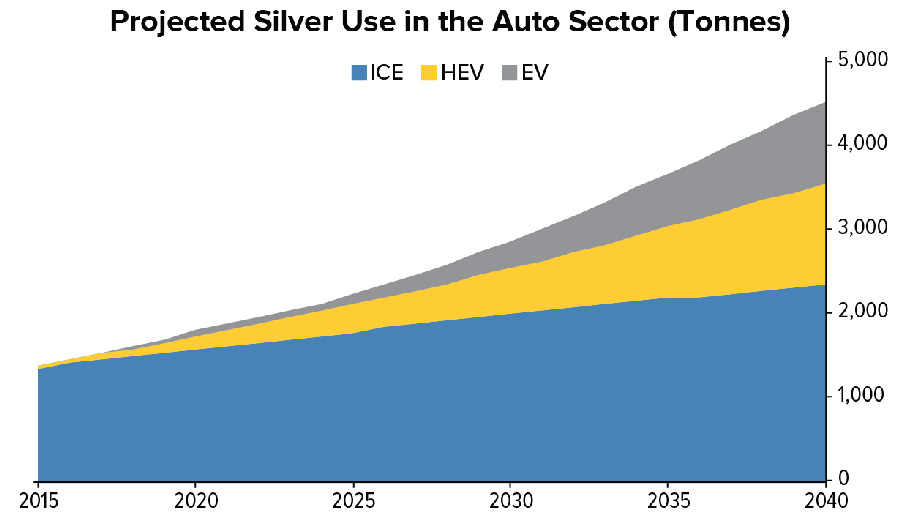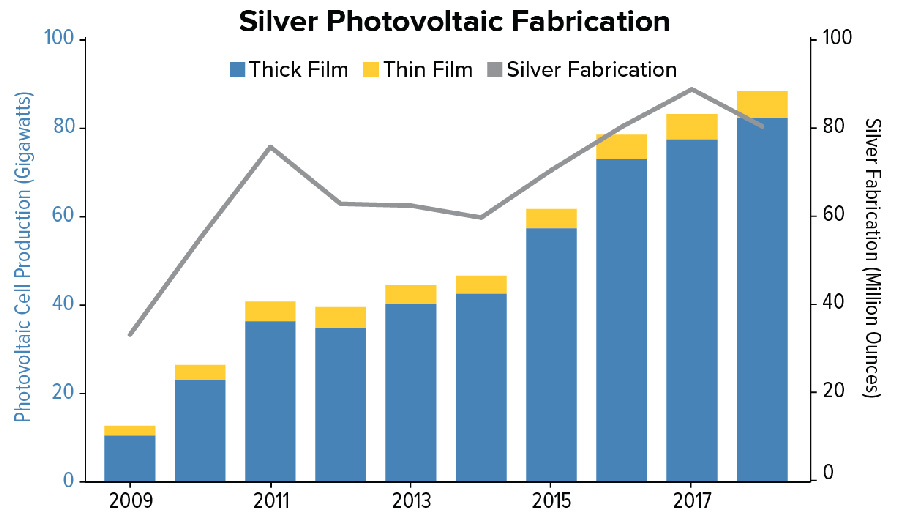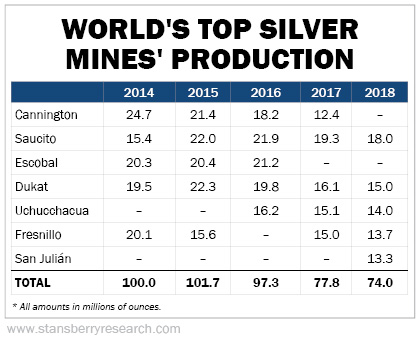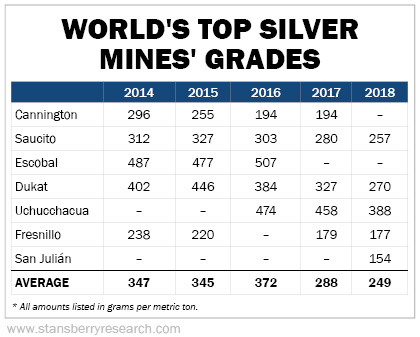As the World Embraces Clean Energy, This Metal's Price Will Soar
by: John Doody
I have been preaching this for YEARS. Check it out. Excellent read
CYA: SE:
*******************************************




I have been preaching this for YEARS. Check it out. Excellent read
CYA: SE:
*******************************************
Editor's note: The price of silver
jumped about 15% in 2019 – from around $15.50 per ounce to nearly $18
per ounce by the end of the year. But as our colleague John Doody –
editor of our Silver Stock Analyst publication – explain in the Weekend Edition, that's nothing compared to what the future holds for the precious metal...
Imagine cruising along a silent highway.
It's rush hour... yet it's quiet. Although the road
is packed with cars rushing to their destinations, one after the
other... the only sounds are the whip of the wind and the crunch of
asphalt under their tires. No engine rumble can be heard. Quiet and
efficient electric vehicles ("EVs") now comprise the majority of all
automobiles on the road.
The formerly empty fields to the sides of the highway
are now filled with farms of silver-coated solar panels. Air-polluting
coal power plants are nearing obsoletion. Shiny photovoltaic ("PV")
panels can be seen on most houses.
These visions of a future powered by renewable energy
may seem fanciful... but in reality, the world is racing to embrace
zero-emissions technologies.
Regardless of how you feel about the science and
politics of the climate change debate, governments around the world are
pressuring the transportation and energy sectors to "do something" about
their carbon emissions. And the industry is responding...
Meanwhile, businesses are finding plenty of
environmentally conscious consumers willing to adopt these technologies –
even if they pay a premium to do it.
Just look at the EV market... Sales are growing at
about 60% a year worldwide. In terms of the total number of cars on the
street, the 2.1 million EVs sold every year are just a drop in the
bucket of the total global fleet. But the rate of adoption has been
torrid.
Research firm McKinsey reported that carmakers around
the world were launching 66 new EV models in 2019... and will release
another 101 models this year. At the Stansberry Conference in Las Vegas
last October, noted short seller Mark Spiegel reviewed the competitive
landscape for EVs and took more than 10 minutes simply listing the new
models coming out from makers as diverse as Kia, Nissan, Ford, BMW,
Maserati, and Aston Martin.
When it comes to investing in precious metals, it's important for you to remember this...
Every one of those EVs hitting the market – as well as the solar panels your earnest neighbor is nailing to his roof – requires silver to work.
The wave of investment going into renewable energy
and the flood of products hitting the market is creating huge demand for
the metal. Even more critical, as you'll see in this essay, this wave
of demand is hitting just as the mining industry is struggling with falling production volumes.
This sets up ideal conditions to own silver stocks in your portfolio today.
Let me start at the top...
Investors often lump silver and gold together as
inflation hedges and stores of value. But that ignores one key
difference between the two precious metals...
All of the world's gold still exists in bar, coin, or
jewelry form. The only demand for gold is for jewelry or investment. On
the other hand, silver is an industrial metal. It's consumed in the
creation of many products because it's highly reflective and is an
excellent conductor of electricity.
Among its uses, silver creates the electrical
connections in EV engines. As the market for these cars and trucks
grows, manufacturers will need more and more silver contact points for
the batteries that power them.
Based on a study by the London Bullion Market
Association, a global authority on precious metals, silver demand for
the auto industry is expected to increase 246% from just more than 1,300
metric tons in 2015 to more than 4,500 metric tons by 2040. As you can
see in the graphic below, the biggest projected growth comes from EVs
and hybrid electric vehicles ("HEVs")... while silver usage in cars
using internal combustion engines ("ICEs") mostly holds steady.

The story is largely the same with
solar panels. Silver usage by the PV industry has increased 900% from 10
million ounces a year in 2009 to nearly 100 million ounces in 2018 (see
chart below). PV usage should continue to grow as an alternative to
traditional dirty coal-powered plants.
The automotive industry will likely continue to be
innovative. We're already seeing photovoltaic installations on car roofs
to power vehicles. PV paint and perhaps even PV road surfaces might not
be too far off. Silver consumption in these uses should continue to
rise exponentially.

And this surge of demand is coming just as global supplies seem to be drying up...
Most silver is produced as a byproduct of other
metals, like copper. Glencore (GLNCY) and KGHM (KGHPF) are large copper
and base-metal miners. They also produce large amounts of silver.
However, Glencore's silver production dropped from
39.1 million ounces in 2016 to 34.9 million ounces in 2018. KGHM's
silver production decreased from 40.4 million ounces in 2014 to 33.9
million ounces in 2018.
If we look only at the top five primary silver mines
of each given year, we can see their total production dropped 26% from
100 million ounces in 2014 to 74 million ounces in 2018.
The top mine in 2014, Cannington, dropped off the
list in 2018 with production falling to less than 12 million ounces per
year. The Dukat mine produced the most silver in 2015 at 22.3 million
ounces, but it produced only 15 million ounces in 2018. Escobal produced
21.2 million ounces in 2016, but it was shuttered by the Guatemalan
government in 2017.

The average grade of these silver mines has been
dropping as well – from an average of 347 grams per metric ton ("g/t")
in 2014 to 249 g/t in 2018 (see table below). Every "Top 5" mine has
seen its grade fall over the past five years. Fresnillo's Saucito mine –
2018's top producer – saw its grade drop 18% from 2014. Dukat's grade
is down nearly 50%.
As grade declines, miners must extract more ore to
produce the same amount of silver. That cuts profitability. Unless the
silver price increases – or someone finds a miraculous high-grade
deposit – miners' margins will continue to be squeezed...
Total silver production will likely drop further. A
silver supply shortage could result... And as the world's silver is
revalued, prices could scream higher.

As this long-term trend plays out in the years ahead,
you'll want to be involved. That's why we believe you must allocate at
least a portion of your overall portfolio to silver right now.
And it's easier than ever to do that with just "one click" in your brokerage account...
You can buy a silver-focused exchange-traded fund
like the Global X Silver Miners Fund (SIL). This silver benchmark
climbed nearly 33% in 2019 – more than doubling the return of silver
(16%) over that span. It even outperformed the S&P 500 Index, which
"only" climbed about 30% last year.
But in our Silver Stock Analyst publication,
we've done much better than that... We eviscerated the competition in
2019, finishing with an incredible 103% gain with our handpicked "Fave
5" model portfolio of silver stocks.
You see, our Fave 5 portfolio is leveraged to the
price of silver. These mining company equities are valued by revenue,
profits, and free cash flow ("FCF"). The miners have relatively fixed
costs, which we measure by our all-in sustaining cost ("AISC") metric.
AISC is largely fixed, so when the price of silver rises, so do miners' profits. The typical silver miner measured by Silver Stock Analyst trades at an average of 10 times FCF. So if profits rise by $1, the stock's market capitalization should rise by $10.
For example, in early 2016 – the last time we saw a
large silver price increase – silver miner First Majestic Silver (AG)
was producing 20 million silver-equivalent ounces a year at $12.50 per
ounce AISC. With the price of silver at $14 an ounce, First Majestic was
generating $30 million in FCF and was trading for a $500 million market
capitalization.
Silver rose 42% over the next six months to nearly
$20 per ounce. First Majestic's levered FCF rose 400% to $150 million.
Its stock price exploded 573% higher.
The silver price is determined by the market forces
of supply and demand. It's rare to find an opportunity where demand is
increasing exponentially while supply (production) is falling off a
cliff.
Silver's price move in 2016 was short-lived. But this
secular shift driven by green energy that we're starting to see play
out right now is unlikely to go away anytime soon.
Silver production is falling. A tidal wave of demand
is building. It's just a matter of time before the market wakes up and
drives the silver price higher.
And while you will likely do well if you simply buy and hold a silver-focused exchange-traded fund, our Silver Stock Analyst Fave 5 portfolio is the best way to play a rising silver price.
Good investing,
John Doody
Comments
Post a Comment